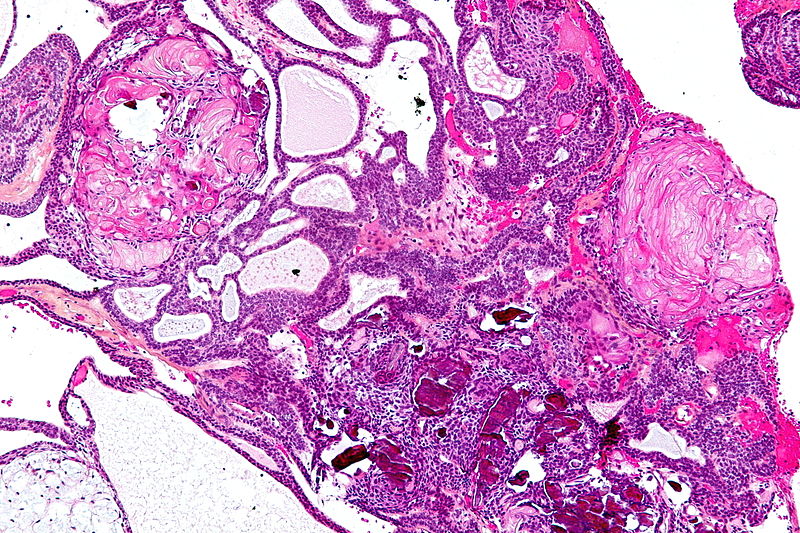Craniopharyngioma pathophysiology: Difference between revisions
Marjan Khan (talk | contribs) |
Marjan Khan (talk | contribs) |
||
| Line 4: | Line 4: | ||
==Overview== | ==Overview== | ||
Craniopharyngiomas are epithelial tumors that usually arise in the pituitary stalk adjacent to the optic chiasm. On gross pathology, craniopharyngiomas are cystic or partially cystic with solid areas. On microscopic histopathology, it is categorized into two subtypes: Adamantinomatous and papillary. | Craniopharyngiomas are epithelial tumors that usually arise in the pituitary stalk adjacent to the optic chiasm. On gross pathology, craniopharyngiomas are cystic or partially cystic with solid areas.The cyst is filled with a turbid, proteinaceous material of brownish-yellow color that glitters and sparkles because of a high content of floating cholesterol crystals On microscopic histopathology, it is categorized into two subtypes: Adamantinomatous and papillary. | ||
==Pathophysiology== | ==Pathophysiology== | ||
Revision as of 14:27, 2 January 2019
|
Craniopharyngioma Microchapters |
|
Diagnosis |
|---|
|
Treatment |
|
Case Studies |
|
Craniopharyngioma pathophysiology On the Web |
|
American Roentgen Ray Society Images of Craniopharyngioma pathophysiology |
|
Risk calculators and risk factors for Craniopharyngioma pathophysiology |
Editor-In-Chief: C. Michael Gibson, M.S., M.D. [1]
Overview
Craniopharyngiomas are epithelial tumors that usually arise in the pituitary stalk adjacent to the optic chiasm. On gross pathology, craniopharyngiomas are cystic or partially cystic with solid areas.The cyst is filled with a turbid, proteinaceous material of brownish-yellow color that glitters and sparkles because of a high content of floating cholesterol crystals On microscopic histopathology, it is categorized into two subtypes: Adamantinomatous and papillary.
Pathophysiology
Gross Pathology
On macroscopic examination, craniopharyngiomas are cystic or partially cystic with solid areas.
Microscopic pathology
The histologic pattern consists of nesting of squamous epithelium bordered by radially arranged cells. It is frequently accompanied by calcium deposition and have a microscopic papillary architecture. Two distinct types are recognized:[1][2]
- Adamantinomatous craniopharyngioma
- Papillary craniopharyngioma.
In the adamantinomatous type, calcifications are visible on neuroimaging and are helpful in diagnosis. The papillary type rarely calcifies. On light microscopy, the cysts are seen to be lined by stratified squamous epithelium. Keratin pearls may also be seen. The cysts are usually filled with a yellow, viscous fluid which is rich in cholesterol crystals. In addition to a long list of possible symptoms, the most common presentation include: headaches, growth failure, and bitemporal hemianopsia.
- Shown below is a micrograph showing the characteristic features of an adamantinomatous craniopharyngioma - cystic spaces, calcifications, and "wet keratin" pearls on hematoxylin phloxine saffron (HPS) stain.
- Shown below is a Micrograph showing a papillary craniopharyngioma on HPS stain.
References
- ↑ Sekine S, Shibata T, Kokubu A; et al. (2002). "Craniopharyngiomas of adamantinomatous type harbor beta-catenin gene mutations". Am. J. Pathol. 161 (6): 1997–2001. PMC 1850925. PMID 12466115. Unknown parameter
|month=ignored (help) - ↑ Sekine S, Takata T, Shibata T; et al. (2004). "Expression of enamel proteins and LEF1 in adamantinomatous craniopharyngioma: evidence for its odontogenic epithelial differentiation". Histopathology. 45 (6): 573–9. doi:10.1111/j.1365-2559.2004.02029.x. PMID 15569047. Unknown parameter
|month=ignored (help)

